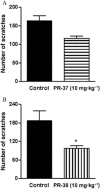Salvinorin A analogues PR-37 and PR-38 attenuate compound 48/80-induced itch responses in mice
- PMID: 26040667
- PMCID: PMC4556471
- DOI: 10.1111/bph.13212
Salvinorin A analogues PR-37 and PR-38 attenuate compound 48/80-induced itch responses in mice
Abstract
Background and purpose: The opioid system plays a crucial role in several physiological processes in the CNS and in the periphery. It has also been shown that selective opioid receptor agonists exert potent inhibitory action on pruritus and pain. In this study we examined whether two analogues of Salvinorin A, PR-37 and PR-38, exhibit antipruritic properties in mice.
Experimental approach: To examine the antiscratch effect of PR-37 and PR-38 we used a mouse model of compound 48/80-induced pruritus. In order to elucidate the mechanism of action of tested compounds, specific antagonists of opioid and cannabinoid receptors were used. The effect of PR-37 on the CNS was assessed by measuring motor parameters and exploratory behaviours in mice.
Key results: PR-37 and PR-38, jnjected s.c., significantly reduced the number of compound 48/80-induced scratching behaviours in mice in a dose- and time-dependent manner. PR-38 was also active when orally administered. The antiscratch activity of PR-37 was blocked by the selective κ opioid receptor antagonist, nor-binaltorphimine, and that of PR-38 by the selective μ opioid receptor antagonist, β-funaltrexamine.
Conclusion and implications: In conclusion, a novel framework for the development of new antipruritic drugs derived from salvinorin A has been validated.
© 2015 The British Pharmacological Society.
Figures







References
-
- Benecke H, Lotts T, Stander S. Investigational drugs for pruritus. Expert Opin Investig Drugs. 2013;22:1167–1179. - PubMed
-
- Bergasa NV, Thomas DA, Vergalla J, Turner ML, Jones EA. Plasma from patients with the pruritus of cholestasis induces opioid receptor-mediated scratching in monkeys. Life Sci. 1993;53:1253–1257. - PubMed
-
- Bigliardi PL, Bigliardi-Qi M. Peripheral opioids. In: Carstens E, Akiyama T, editors. Itch Mechanisms and Treatment. Boca Raton, FL: CRC Press; 2014. pp. 1–12. chapter 18. In: (eds).
-
- Bigliardi PL, Tobin DJ, Gaveriaux-Ruff C, Bigliardi-Qi M. Opioids and the skin – where do we stand? Exp Dermatol. 2009;18:424–430. - PubMed
Publication types
MeSH terms
Substances
Grants and funding
LinkOut - more resources
Full Text Sources
Other Literature Sources
Medical
Research Materials

